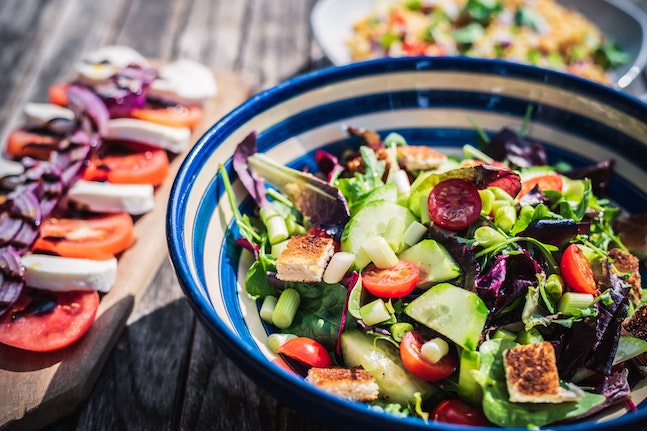How you eat contributes significantly to your carbon footprint — find out how to adopt a low-carbon diet
I’ve had the great pleasure of interviewing many farmers and scientists at the forefront of environmental research. There is a minefield of conflicting research, ideas, evidence and arguments out there: the same crop can be destructive in one location, but healing in another; the same animal can cause topsoil wipeout when farmed one way then produce healthy soil when farmed another way. These grey areas mean one thing: we must form deeper connections to our food system.
I’ve prepared a list of many of the things you can do to play a positive role in healing the planet, no matter your beliefs or dietary requirement. The good news is you don’t have to wait for the perfect political candidates to do any of these things — you can start today.
Food waste
We share common demons when it comes to climate change debates: air travel, cows, fossil fuels. Air travel, factory farming/industrial agriculture and fossil fuel burning are big players when it comes to the changing climate, but what about food waste? Research shows that food waste is responsible for about 8 per cent of global annual emissions. When compared to air travel, which sits at 2 per cent of global annual emissions, we need to be looking into food waste in our homes.
Consider this: as much as 20 to 40 per cent of fresh farm produce, depending on the country doing the reporting, is discarded due to “unacceptable aesthetic standards” for large supermarket chains. Can you believe it? One in nine people are going hungry around the world every day while food waste is contributing to 8 per cent of total global carbon emissions … and we’re worried about a bruise on an apple and are therefore not selling it!
These forms of agriculture give more back to the planet than they take in the way that they sequester more carbon than they produce with their specific farming models.
If we were able to use all the food that was produced or brought, it would be the equivalent of taking half a billion cars off the road, according to a joint CNN and Project Drawdown report in 2019. Moreover, 5 per cent of food is wasted in the average processing plant for packaged, processed foods such as biscuits, sauces, milk and spaghetti. The average Australian family wastes just under $2000 worth of food a year. Imagine what some families could do with that extra money for the family’s resources throughout the year!
We are underskilled in the art of managing our grocery stock, we have demonised leftovers, and we have glorified being able to decide whatever we want to eat for the next meal, ignoring the fact that we have food in our fridge already, and we must change. Our governments must, too. Imagine the government buying that food from the farmers to distribute to food banks so their clients could eat more fresh produce and less of the packet foods that often create key deficiencies and produce negative health outcomes mentally and physically over time. Less food from farms would be wasted, people would be lifted out of hunger, health costs for malnourished people would go down and there’d be less produce rotting in piles on farms and emitting carbon.
So what can you do? If you’re not already a confident kitchen maven, start following people online who do clever things with leftovers and food waste. Stop asking yourself or your family “what you feel like” every meal; instead look inside the fridge or pantry and create something delicious for your next meal. If we all did that a couple of times a week, we wouldn’t be throwing away a fifth of our groceries.
Compost
Compost like the health of the planet depends on it! There are community resources, subsidised compost bins in some council areas, local workshops, online tutorials, compost pickup systems in various cities and communities and some councils that allow you to pop compostables into your green bin for council collection. Not only will you be able to downgrade your bin size overnight, you will also contribute to the enrichment of the soil on which you live. You’ll also be leaving scraps out of the landfill system where they turn to methane trapped under a pile in the hot sun in the middle of “nowhere” which, unfortunately, is very much “somewhere”. That somewhere will edge closer and closer to us the more we throw away over time.
Eat nutrient-dense foods
Think about how many iceberg lettuce leaves you’d have to eat to feel satisfied versus dark Tuscan cabbage leaves tossed in some olive oil with sea salt and lemon juice. Iceberg lettuce barely touches the sides of the ribcage, while a field of Tuscan cabbage could deliver you more nutrient density at a fraction of the space needed to grow it.
Think about how you can increase the nutrients and reduce the amount of “empty foods” and start to be conscious of raising the level on the nutrient front and decreasing the volume you consume.
Source from farms, not factories
Did you know that sometimes our local produce is sent overseas to be processed and then returned to us? Fish caught in Australia sustainably, for example, may quite possibly then be bundled off to Asia for processing and then sent back here to be sold frozen. Read labels. Ask questions. Shop with local suppliers who have a clear picture of the supply chain. You’ll quickly start to see what the best sources are.
Source locally where possible
Remember the 80/20 rule. If you source locally most of the time, that’s great. Bonus points if it’s local and produced using a form of agriculture described in my next point. There are some fabulous initiatives by organic or community-supported agriculture box delivery services facilitating the localisation of the food system by informing you exactly which farms the produce comes from, and even in a couple of cases allowing you to select the kilometre range from which your food comes.
It’s not the what, it’s the how
A few published reports say that up to 85 per cent of a food’s impact on carbon emissions is made before that food leaves the farm gate, so while “eat local” makes a lot of sense, so does the way in which we farm. Source from farms using less synthetic, intensive chemical inputs and more from farms that are farming regeneratively, biodynamically or using permaculture principles. These forms of agriculture give more back to the planet than they take, by sequestering more carbon than they produce with their specific farming models. The Rodale Institute in Pennsylvania, USA, has been researching farming methods that give back to the land since Bob Rodale founded the concept of regenerative agriculture after his father spearheaded the organic farming movement a generation prior. It turns the superficial calculations of which foods are the “demons” and which are the “heroes” based on their carbon emissions around to being a call for an improvement on how we farm, rather than solely being focused on what we farm.
Doing better than we did yesterday is how we create a truly healing and healthy food system for us and our planet.
For too long the entire food emissions debate has been “meat versus plant-based”. Instead, the driving question must be “how is it grown?” It’s not the what, it’s the how, it seems. If a cow is raised on a farm in a tightly packed herd in the way these types of animals have traditionally moved across lands, and rotated through paddocks so that grass is never run down beyond being able to grow back, with all the insects and pooping and trampling that occurs in that process, evidence suggests that this has a very powerful place in the agriculture of the future, along with all forms of beneficial, soil-nurturing agriculture in the plant world.
There have been some fascinating desertification reversals around the world at the hands of farmers such as Allan Savory, Joel Salatin and Charles Massy and some amazing stories of the impact of restoring healthy water systems to the land. It’s an exciting time to think we can go much deeper than being carbon accountants at a top level and become deep land healers by looking at what tools the planet needs to work best, based on location, topography and more.
Grow something organic
Follow people you find inspiring online and start with a few herb pots in your garden or balcony. There is no shortage of inspiration online to get you going wherever you live and however much space you might have. I haven’t had much space at all beyond a few herb pots these past few years, but at last we have a great terrace on which to start our spring planting, and for that we are excited to make our small contribution to bringing a few more delicious plants into the world — the most local, least intensive possible food we could eat.
Healthy food system for all
So, there you have it. Hopefully that’s helped you widen the lens from the tiny focal point of “How much carbon was emitted in producing this guacamole?” to “Where can I locally get avocados from a grower farming in a way that nourishes the lands on which they farm?” And if there isn’t one anywhere near you, ask “What could I be eating from around here that comes from great farms giving back to the lands and keeping the topsoil healthy?”. A more holistic approach allows for every type of eater to do better to be a part of creating a regenerative food system.
Hopefully these few ideas will create a positive impact on the foods you bring into your home and what you do with them once you have them. I hope they will help you use everything up to its maximum potential and that any scraps become part of a circle of life to produce more beautiful foods instead of ending up in landfill. Don’t be daunted by the initial minefield as you start to unpack what you’re eating, where it comes from and how it’s produced. This isn’t an overnight awakening where you magically become an expert carbon sequestration/reduction ninja. Take your time, read things, ask people and write inquiry emails. It’s a project for a good year’s worth of inquiry and the result is a lifetime of lower carbon impact. Starting is always better than not starting because you’re worried you won’t be perfect. Doing better than we did yesterday is how we create a truly healing and healthy food system for us and our planet.








